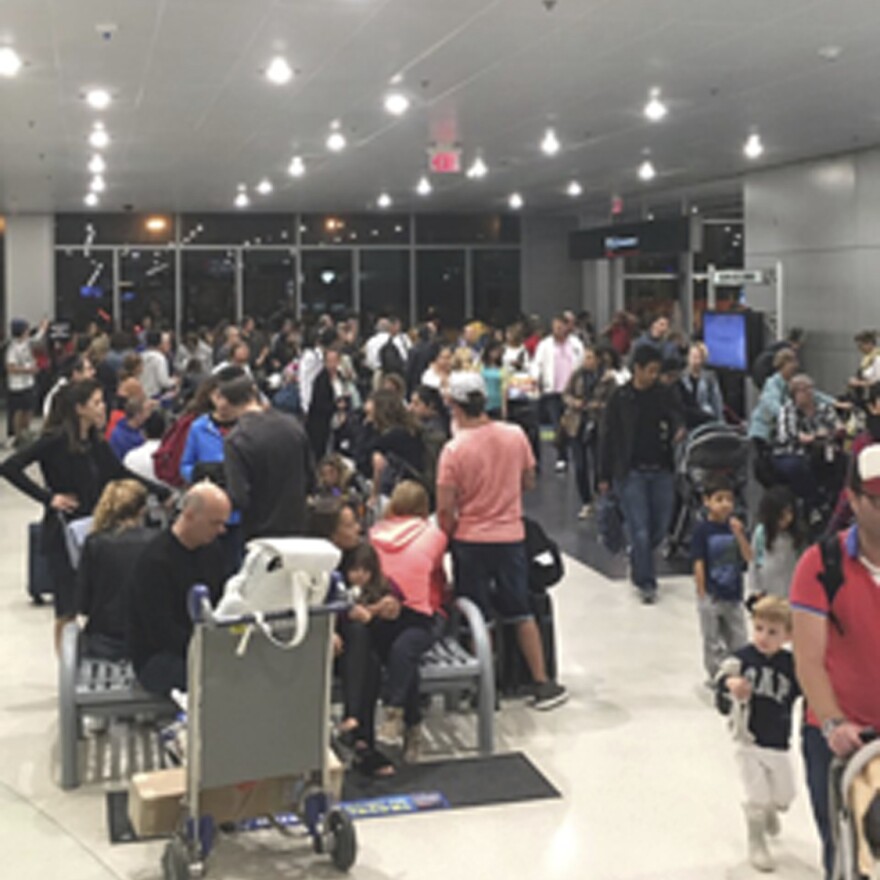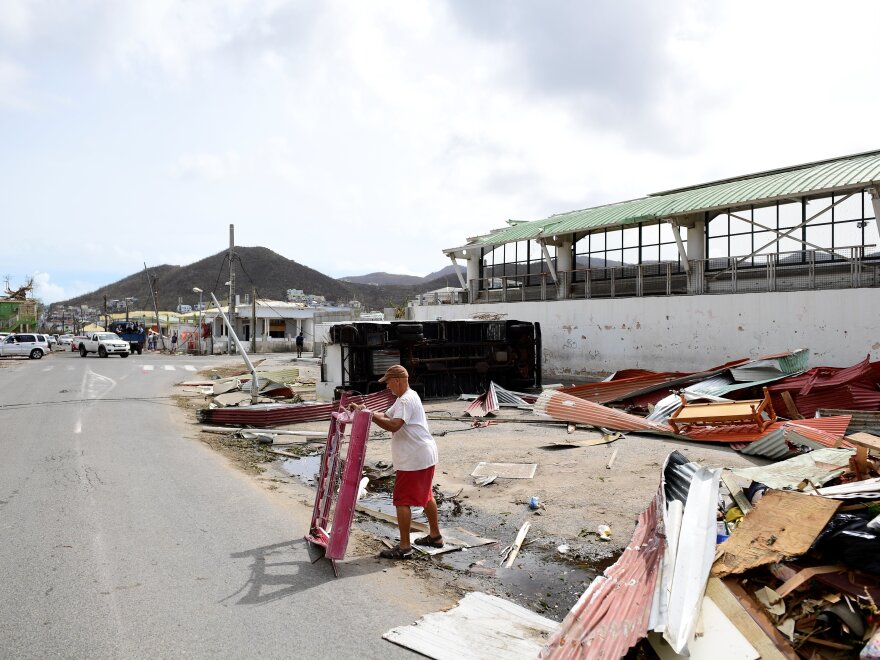Updated at 6 a.m. ET Saturday
Hurricane Irma is again a Category 4 storm as it slowly moves along the Cuban coast. The storm made landfall on the Camaguey archipelago of Cuba late Friday, according to the National Hurricane Center. As of 5 a.m. Saturday, the hurricane's center was just off the northern coast near central Cuba. The report puts Irma's traveling speed at 12 mph, about 245 miles south-southeast of Miami.
About 5.6 million people in Florida have been ordered to evacuate; forecasters expect the hurricane to hit Florida early Sunday morning.
The hurricane center continued its alerts about not just high winds and rain, but also the expected storm surge, saying surge warnings have been "extended on the east coast of Florida to the Volusia-Brevard County Line and on the west coast of Florida to Anclote River, including Tampa Bay." Hurricane warnings cover the same area.
Earlier Friday evening, Florida Gov. Rick Scott warned his state's residents that Hurricane Irma could be a major catastrophe and, in no uncertain terms, urged people to heed orders to evacuate.
"Our state has never seen anything like this before. The majority of Florida will have a major hurricane impact with deadly storm surge and life-threatening winds," he said in an evening news conference.
He said the lower half of state will soon be in danger of a life-threatening storm surge.
"If you have been ordered to evacuate, you need to leave now. Not tonight, not in an hour. Now."
Scott said there is no area in the state where people will safe on their own.
"This storm is wider than our entire state, and it is expected to cause major and life-threatening impacts from coast to coast." he said.
Early Saturday, the National Weather Service warned residents of the Florida Keys to leave immediately, saying, "The Keys are not safe."
It's not too late to get off the Keys!!! You still have time, this morning, to get out! Please, the Keys are not safe. #FLkeys #Irma pic.twitter.com/9NYqL7PsPT
— NWS Key West (@NWSKeyWest) September 9, 2017
In South Carolina, Gov. Henry McMaster ordered a mandatory evacuation, starting Saturday morning, of barrier islands in Jasper, Colleton and Beaufort counties.
Alabama Gov. Kay Ivey has declared a state of emergency in anticipation of Hurricane Irma's arrival.
Hurricane Irma slammed through the Turks and Caicos Islands en route to a destructive encounter with Florida this weekend. It began hitting Cuba and the Bahamas with hurricane conditions Friday as a massively powerful and "extremely dangerous" system, forecasters say.
Irma's dangerous "eye wall," has been threading its way through the gap between Cuba and the Bahamas on its way toward Florida.
The extent of the Irma's damage to the low-lying Turks and Caicos island chain, located just east of the Bahamas, still isn't clear. Preliminary reports from the BBC say that the islands were "pummeled" and that at least 14 people were killed. The islands' emergency management agency issued an "all-clear" shortly before 1 p.m., but it also warned that "many roads have been flooded and power lines and transformers are down." Forecasters had predicted Irma would hit the area with powerful winds and waves as high as 20 feet.

The National Hurricane Center says the center of Irma "will move near the north coast of Cuba through Saturday, near the Florida Keys Sunday morning, and then near the southwest coast of Florida Sunday afternoon."
"Some fluctuations in intensity are likely to continue during the next day or two," the agency said in its 11 p.m. briefing, "but Irma is expected to remain a powerful hurricane as it approaches Florida."
Forecast for Irma: Cuba, the Bahamas and Florida
Irma, which is one of the most powerful hurricanes ever recorded in the Atlantic, is set to barrel between the northern coast of Cuba and the southern Bahamas on its way toward Florida.
Meteorologists believe that after making landfall as "at least a Category 4 hurricane" in the Keys by around 2 a.m. Sunday, the storm will move up through Florida toward Georgia.
"After landfall, a fairly quick decay in maximum winds is expected due to land interaction and increased shear," the hurricane center says, "although Irma's large wind field is likely to still produce hurricane-force winds over a large area."
Irma's hurricane-force winds extend up to 70 miles from its center, and its tropical-storm-force winds extend up to 185 miles.
A massive evacuation was ordered for islands in the southeast of the Bahamas chain. The Tourism Ministry in the Bahamas said thousands of tourists had left ahead of Irma's arrival.

Cuban residents on the northern coast were under a mandatory evacuation order and thousands of tourists were evacuated from low-lying keys off the Cuban coast on Thursday in anticipation of the storm surges, according to the AP.
Florida girds for Irma
At a news briefing early Friday, Federal Emergency Management Agency Administrator Brock Long warned that parts of Florida could be without electricity for days or weeks and that more than 100,000 people in the state may require shelter.
"Hurricane Irma continues to be a threat that is going to devastate the United States in either Florida or some of the southeastern states," he said.
Florida Power & Light CEO Eric Silagy said Friday that given Irma's current strength and path, the storm is likely to impact 4.1 million electricity customers — or some 9 million people, NPR's Greg Allen reports.
In Miami, officials are opening new shelters to handle the thousands of people who are looking for safety during the storm. Anticipating possible water outages due to Irma, the Miami-Dade County emergency agency advises residents to fill "bottles, pots/pans and all containers you have."

The emergency agency is also encouraging people in Irma's path to download a variety of apps, from local 311 information services to Florida 511 for traffic status and Gas Buddy for updates on fuel availability.
Describing what areas hit by a hurricane the size of Irma can expect to experience, the hurricane center says, "Well-built framed homes can sustain severe damage with loss of most of the roof structure and/or some exterior walls. ... Most of the area will be uninhabitable for weeks or months."
Some areas could see a surge of 6 to 12 feet. Hurricane warnings are also in effect for Lake Okeechobee and Florida Bay.
With damage expected from wind, rain and water surges of 6 to 12 feet along the storm's path, Long said, "Anybody from Alabama to North Carolina should be watching this storm very closely."
Wreckage in the Caribbean
Bahamas Power and Light says electricity service in several of the Bahamas' islands was lost Friday morning. Preliminary reports say Long Island and Crooked Island escaped major structural damage.
On Thursday, Irma skirted just north of Hispaniola, an island split between the Dominican Republic and Haiti, sparing those countries the full force of its winds and storm surge.
Earlier, Irma had also passed to the north of Puerto Rico, knocking out electricity to more than a million people in the U.S. territory. The island's fragile infrastructure is expected to present a major challenge, and authorities say it could be months before power is restored to some rural areas.

Two outlying Puerto Rican islands, Vieques and Culebra, got hit hardest. NPR's Jason Beaubien, reporting from San Juan, says that those islands got hit "incredibly hard" and that the territory's governor, Ricardo Rosselló, declared them a disaster.
"People there say the destruction was like the end of the world," Jason says.
Several other Caribbean islands, including Barbuda, St. Martin/Sint Marteen, Anguilla and the Virgin Islands, were not so lucky. The level of destruction on some has been described as nothing short of apocalyptic. And Hurricane Jose, another major storm close on the heels of Irma, is forecast to hit some of the same islands on Saturday before veering north.
The U.S. Consulate General in Curaçao says that it believes about 6,000 Americans are stranded on St. Martin and that it was working to try to get them to safety.
"We are exploring every possible option to assist U.S. citizens there," a State Department official tells NPR. "However, there is no U.S. Consulate on the island, and we currently cannot access the island."
At least four people are dead in the U.S. Virgin Islands, and officials there said they expect to find more bodies. Dozens of patients were rescued from a destroyed hospital on the main island of St. Thomas to neighboring St. Croix and Puerto Rico. A pair of Air Force C-130s were flying in supplies to the stricken islands.
U.S. Virgin Islands Gov. Kenneth Mapp imposed a 6 p.m. curfew, saying the focus is on "making sure people have meals, water and shelter." He called the magnitude of the storm "very chilling."
At least one person, a toddler, was killed in Barbuda, where officials said nearly every building was damaged or destroyed.
On severely damaged St. Martin, which is half-governed by France and half by the Netherlands, Dutch forces were helping maintain order and distributing aid, according to The Associated Press.
The news agency says Dutch Prime Minister Mark Rutte had told reporters Friday that the first planeload of relief aid had landed and that Dutch navy ships were also unloading supplies.
French Interior Minister Gérard Collomb said that a total of nine people have been confirmed dead on French-administered islands and that seven more are missing. Collomb says supplies and relief workers are being rushed to the area ahead of Jose's predicted arrival Saturday.
In French St. Martin, there were reports of looting as military planes transported in police and rescue crews, the AP says.
Still, the prime minister of St. Lucia, elsewhere in the Caribbean, sounded a note of resolve in his news conference Friday.
"While it's OK to use the word 'devastation,' but it doesn't mean 'annihilation,' " Allen Chastanet. "We are resilient."
Copyright 2020 NPR. To see more, visit https://www.npr.org. 9(MDAyNDY5ODMwMDEyMjg3NjMzMTE1ZjE2MA001))










